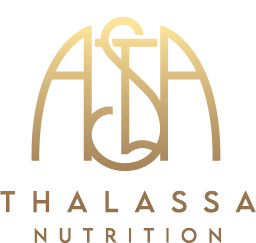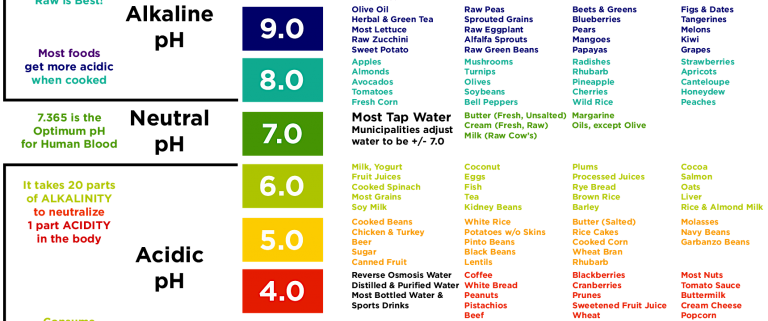What is pH?
Why is pH important?
According to many experts, a healthy body has a balanced alkaline to acid pH level. Your pH levels are directly influenced by the foods you eat. The Standard American Diet (S.A.D.) contains more acid-forming foods than alkalizing foods. Picky eaters many times eat mostly acid-forming foods. Unfortunately, too much acid can cause health problems.
A balanced pH environment allows normal body function necessary for the body to detoxify. This enables our bodies to resist disease. A healthy body maintains adequate alkaline reserves to meet emergency demands. When excess acids must be neutralized our alkaline reserves are depleted, leaving the body in a weakened condition. Acidosis is an over-acidity in the body tissues and is one of the basic causes of diseases. Acidosis forces the body to take minerals, including calcium, sodium, potassium and magnesium, from vital organs and bones to buffer (neutralize) the acid and safely remove it from the body. Because of the strain that is put on the body, it can suffer severe and prolonged damage due to high acidity.
“The real problem is one of alkaline deficiency, more than one of too much acid,” states Anthony Sebastian, M.D., of the University of California, San Francisco. “People eat plenty of acid-yielding animal protein, dairy products, and grains. The missing piece is an appreciate amount of fruits and vegetables, to produce an alkaline yield. Study after study has shown that most Americans–68 to 91 percent–don’t eat the five recommended daily servings of fruits and vegetables.”
Test pH Levels at Home
Your pH levels can be tested quickly and easily right at home. In fact, every home should have pH strips to measure alkaline/acid balance in the family medicine chest, right alongside the thermometer. Both offer vital information on the body’s systems. Purchase pH test strips at a local pharmacy, whole foods store, garden nursery, or even pool supply store. Babies are born with a pH level of 7.4. Levels should be slightly alkaline and a healthy pH level is between 7 and 7.5, although 6.5 is considered in the normal range. The best time to test your pH is about one hour before a meal and two hours after a meal. Remember, that pH levels will vary throughout the day.
Green Food Is Yummy
After a glance at the following two lists, it becomes painfully clear why so many children and adults are ill. The first list contains acidic foods: most processed foods, fast foods, dairy, and meat. They are all acid forming, that is the effect they have on the body, not the taste. Some of these foods should be eaten in moderation, some not at all. Fast foods are acidic and are not part of a healthy diet. If your pH level is too acidic, for at time altogether avoid the foods on the acidic list. Dairy, whole grains, and meat are a part of a balanced diet. After pH has been restored, begin adding them back into a healthy diet.
The second list contains alkaline forming foods. Not surprising, most fruit and vegetables are on this list. These are foods to emphasize every day in your diet and to eat exclusively to bring an acidic level back to balance. Vegetables are alkaline and necessary for health. Unless a picky eater learns to eat whole foods, especially veggies, you can expect a lifetime of health challenges. To maintain a healthful alkaline blood pH at least 80 percent of total food intake should be alkaline foods and 20 percent acidic foods. This is always challenge for a picky eater, who avoids whole foods, especially veggies. The good news is you can transform your picky eater into a healthy eater.
These statements have not been evaluated by the Food and Drug Administration and are not intended to diagnose, treat, cure, or prevent any disease. Research is ongoing.
Shift pH balance:
Alkaline Forming Foods
These are foods to include, especially when balancing acidic pH levels:
Vegetables
Beans
Nuts & Seeds: almonds, pumpkin, sunflower, sesame, flax, spelt, lentils, sprouted seeds
Sprouts
Oils: flax, avocado, extra virgin olive oil, evening Primrose, borage & coconut oil
Most Fruit: especiallycitrus (lemon, lime, orange, grapefruit, etc.), grapes and raisins, avocado, tomato & melons
*Apple Cider Vinegar causes one’s pH levels to become more alkaline. Apple Cider Vinegar in itself is alkaline because of its ash content. Once the body has burned the apple cider vinegar, what’s left over becomes ash. When you check for the pH of that ash and dissolve it with water, the content is alkaline. For adults the recommended dosage is 1 to 2 tablespoons in an 8 ounce glass of water, several times a day. Adjust your dosage of Apple Cider Vinegar mixed in a glass of water according to your pH level.
For more info on Apple Cider Vinegar, including recipes,
Water and Goat’s Milk are neutral
Acidic Forming Foods
Following are foods to avoid with a high acidic pH level.
Once pH has been restored to a proper balance, include meat, dairy, and grains to about 20 percent of your diet.
All Meat and Dairy: except goat’s milk(Dairy products are a part of a healthy diet, but when pH levels are acidic, avoid dairy until your pH levels are normalized.)
Crustaceans (shrimp, lobster, etc.)
Sugar & Condiments
Coffee & Tea
Some Fruit (When pH levels are acidic avoid these fruits until your pH levels are normalized: blueberries, canned or glazed fruits, cranberries, currants, and plums.)
Most Grains: wheat,pasta, rice (although, brown rice is low acid-forming), oatmeal
Nuts: peanuts, cashews, pistachios
Fast foods
Oils: margarine, corn oil, vegetable oil, sunflower oil & hydrogenated oils
Vinegar (except for Raw Apple Cider Vinegar*)
Raw Organic Apple Cider Vinegar
Organic Apple Cider Vinegar has been used to cure and prevent a variety of ailments for centuries. As early as the time of Hippocrates, vinegar was used to treat patients. There are hundreds of uses for Apple Cider Vinegar (ACV), it could fill volumes. I’ll just hit the highlights.
ACV is a naturally fermented food with antibiotic and antiseptic qualities that fights germs, bacteria, mold, and viruses. It’s rich in enzymes and potassium, naturally supporting a healthy immune system. ACV contains over forty vitamins and minerals, including potassium.
There are studies confirming that ACV helps with weight loss and lowering blood sugar levels. Many of the accounts of ACV helping and even curing illnesses are anecdotal. For me, thousands of anecdotes equal data. In my experience, ACV stopped my acid stomach, stopped the effects of food poisoning for my daughter and again for a son-in-law. ACV stopped my 12-year-old granddaughter’s asthma cough in only two days. To our surprise, she began to have regular bowl movement’s shortly after including ACV in her daily routine. Seems this is another benefit.
Among other things, cider vinegar is very effective in detoxifying various organs, kidneys, bladder, liver etc., by keeping a proper alkaline/acidic balance in the body. It is a purifier, as it has a means of breaking down fatty, mucous, and phlegm deposits within the body. Cider vinegar also helps oxidate the blood which consequently prevents the blood from becoming too thick and gluey, which gives rise to a strained heart and blood vessels resulting in high blood pressure.
ACV promotes digestion and pH balance, it’s said to help soothe dry throats, helps remove body sludge toxins, helps maintain healthy skin, soothes sunburned skin, and relieves muscle pain from exercise. It’s said to kill yeast and fungus infections. ACV releases toxins from the liver and is reported to help numerous ailments including arthritis, high blood pressure, skin conditions, high cholesterol, insomnia, fatigue, liver and kidney problems, asthma, allergies, weight loss, indigestion, and acid stomach. ACV even is even a remedy for morning sickness.
This wonder food costs just over four dollars for a quart. It’s recommended to take 1 tablespoon in eight glasses of water at meals and before bed. The recommendation for children is one teaspoon in a glass of water. Vinegar has a strong taste, so some people may want to add it to apple or orange juice. If you purchase pH strips at a whole foods store, you can easily track your pH levels (7 to 7.5 is optimal). Less than seven is acidic and higher is alkaline. Then adjust the amount of ACV you take: more if too acidic, less if too alkaline.
The cheaper white vinegar is a fantastic cleaning solution. Use it on pots and pans, dishes, cutting boards, full strength with baking soda for unclogging drains, diluted for windows. When my dogs leave a yellow spot on my rug, I dilute it in water, pour it on the spot, and wet vac away the spot and the odor. I’ve heard that sprayed on the ground, it will kill ants.

 no
no no
no NO
NO
Leave a Reply
Want to join the discussion?Feel free to contribute!